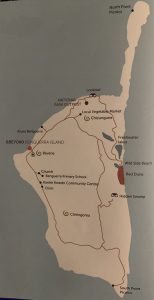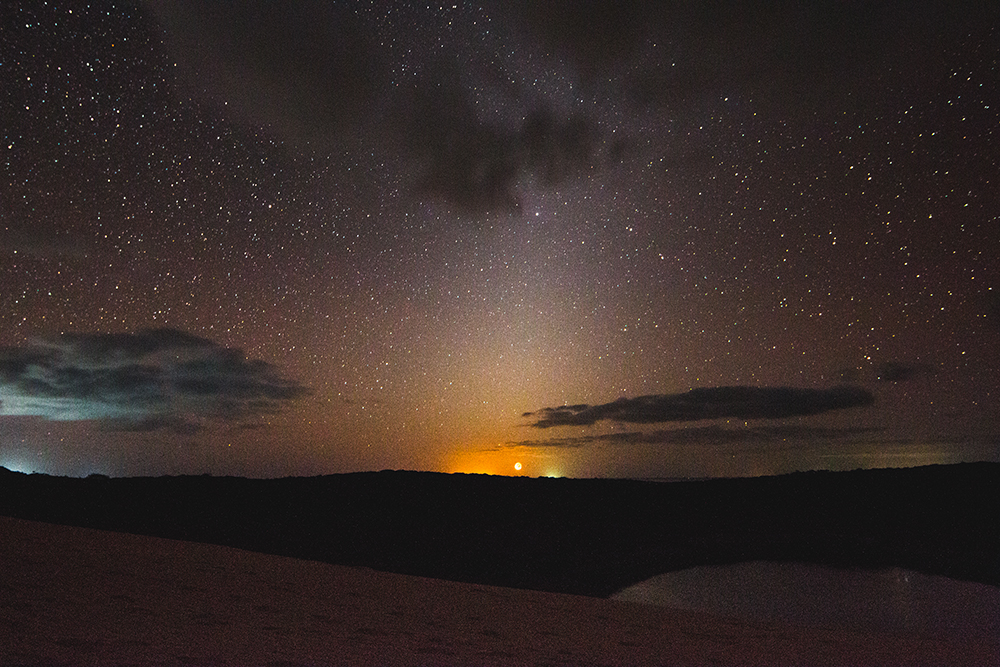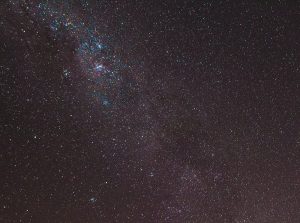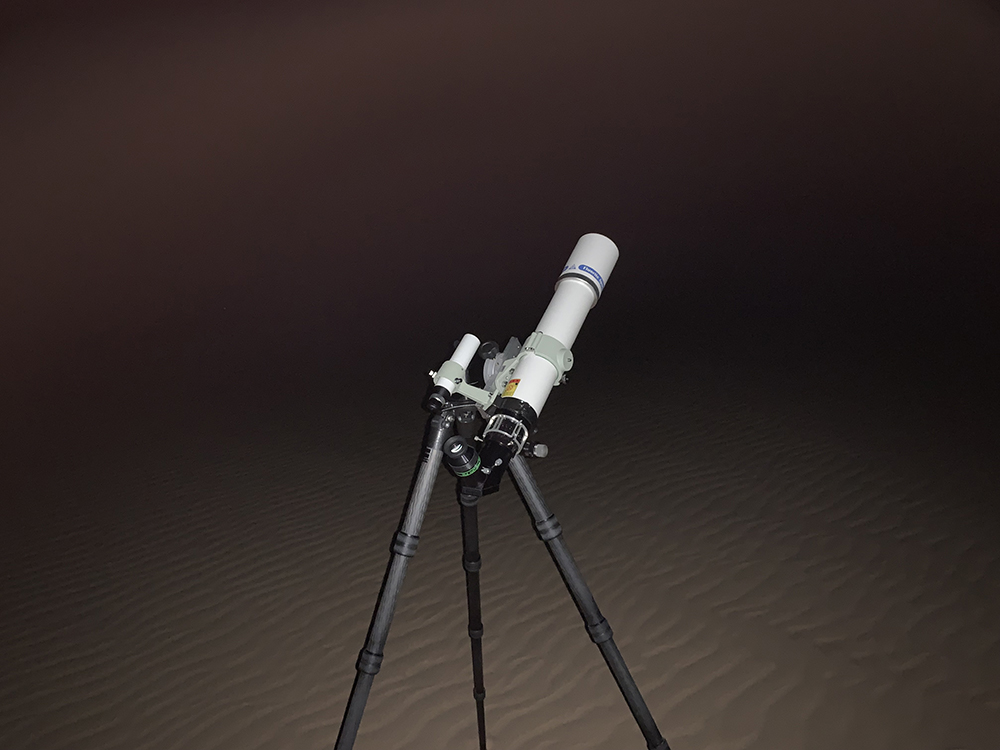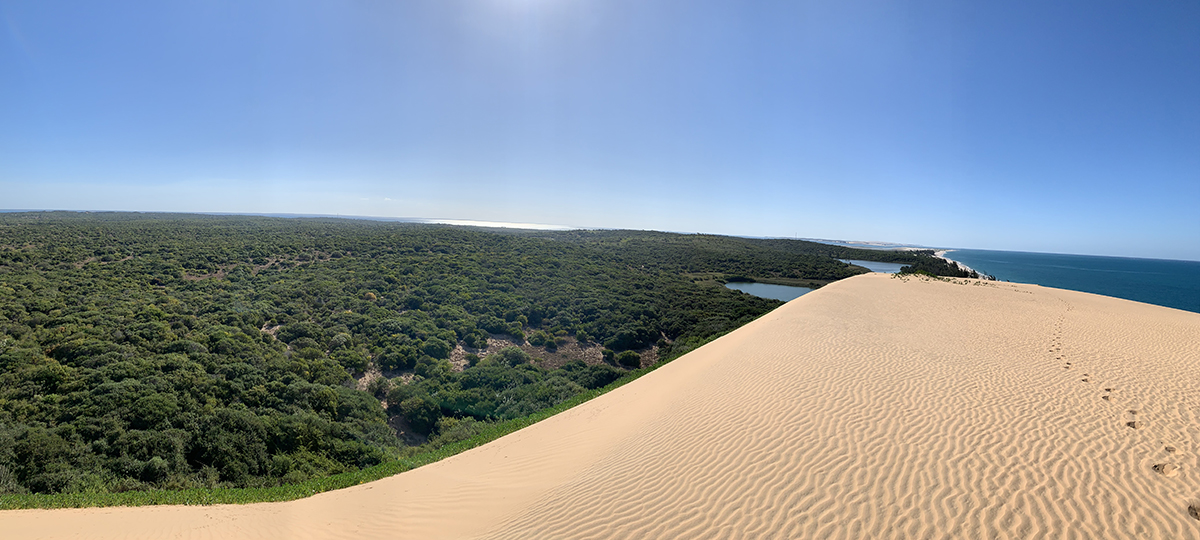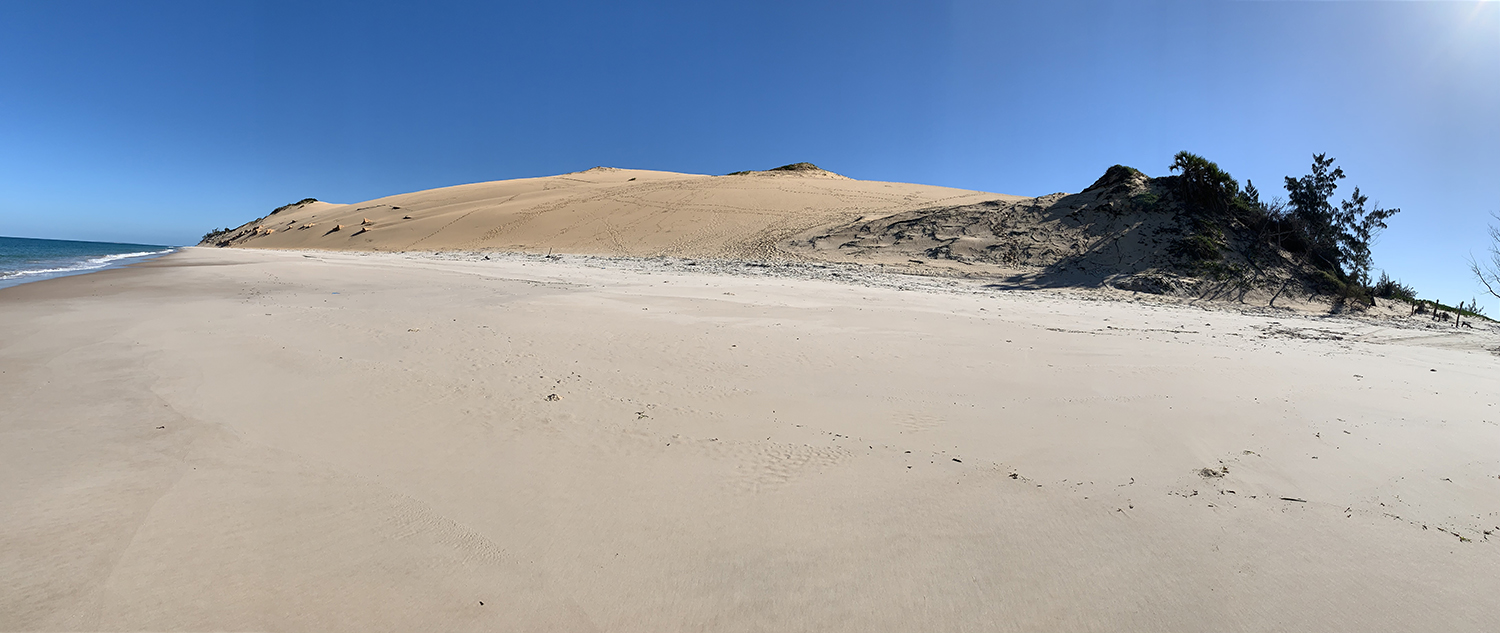
This photo does not do justice to the size of this dune, which stands well over 200 feet high. When you reach the “top” of what is visible, the same amount again is there waiting to be climbed!
A few days into our vacation on Benguerra Island, management of the resort realised how seriously I was taking my stargazing and offered to take me one evening over to the Red Dune on the south side of the island for another astronomy session. While I could hardly complain about setting up my scope on the beach in front of our villa, under amazingly dark Bortle Class 2 skies, the one weakness was the tall palm trees that lined the edge of the beach, blocking the view of the skies to south to about 10-15 degrees above the horizon, and occasionally a local fishing vessel would illuminate the beach when bringing in a catch, briefly impacting dark adaptation.
Red Dune on the other hand is a solitary sand dune on the other side of the island, stretching to 29-stories in height (at least according to my FitBit) and has full 360o views being the tallest point on Benguerra, which would provide a wonderful vantage point for some stargazing. When the question was raised by the activities manager about who would drive me over to the dune, Grant, who is head of maintenance actually volunteered as he has a strong interest in astronomy and owns a small telescope. It was certainly nice to have an observing buddy for the evening, as my Astro-sessions on holiday are normally solitary affairs.
Observing Session
Due to high winds, the trip was delayed by one day which put a 2-day old waxing crescent, low in the west, though setting by 7pm (30 mins after astronomic dusk), and at magnitude -3.1, it did not completely wash out the zodiacal light which it was firmly in the middle of, so there was minimal impact on hunting my DSO quarry.
After hiking up the south face which had the shallowest incline, I quickly set up the scope and could not resist a quick peak at the waxing crescent Moon and the Beehive Cluster in the same low power field at 24x. While the Moon hid from view some of the dimmer cluster members, the boxy core surrounded by a small swarm of bees was still apparent, all nestled in the ghostly glow of the zodiacal light which was noticeably brightening the background sky.
After missing out on two of my favourite open clusters a few nights before thanks to an interloping palm tree, I swung the scope over to Puppis and the Messier OCs, M46 and M47. Only about 6o above the horizon, atmospheric extinction was robbing them slightly of their resplendent shine, but taking them both in the same view at 24x was still a wonderful sight. Both appear similar in size, though in reality M46 is far larger but more distant, the spherical shape with a spiral structure I always see when viewing this cluster, mapped out by stars of equal brightness was still quite obvious. In contrast, M47 showed no apparent arrangement as though several tiny jewels had been dropped and bounced on black cloth.
Next up was the Lambda Centauri Cluster (C100) which is rather easy to find, located on the brightest star on a line between Alpha Crucis and the Eta Carinae nebula. At 24x, there was a hint of a gaseous swirl of nebulosity around Lambda Centauri itself with averted vision, but nowhere near the extent seen in long exposure photographs. Taking the power up to 57x with the 10mm Radian, revealed a couple of chains of bright stars including a “U” shape near one end of the cluster, with most of the stars seemingly concentrated about half a field away from Lambda itself.
Continuing the theme of open clusters, our next target was NGC 3114 in Carina. Visible to the eye as a pale condensation in this busy region of the Milky Way, no star hoping was necessary, though following a straight line from p Carinae (just below the Eta Carinae nebula), and Iota Carinae would bring this cluster into view. Using the 7mm for 81x, the cluster was extremely rich with dozens of tiny blue-white stars randomly strewn across a bright background canvass of the Milky Way, which actually made it hard to tell the full extent of the cluster’s boundary. In stark contrast to most of the cluster members, two stars possessed a distinctive yellow hue, though they may well be unrelated field stars.
Staying in Argo Navis, our next target was another open cluster, this time in the giant sail Vela, which powered Jason and his argonauts on their journey to retrieve the golden fleece. Using magnitude +1.8 Gamma Velorum (Suhail al Muhlif), the brightest star in Vela, as a starting point, less than 2-degrees east was NGC 2547. At 81x, the cluster filed the central third of the field, with a boxy structure of bright stars near the centre with two obvious arcs of stars around the periphery, and smaller swirls of tiny stars between the two structures.
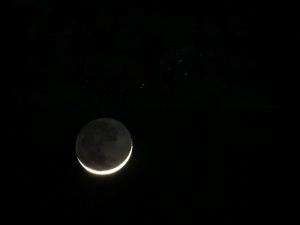
Using eyepiece projection and my iPhone, I captured the two day old waxing crescent moon and the brightest members of the Beehive Cluster (M44). Click for larger image.
Before changing tack and moving onto some nebulae, two more open clusters were on the hit list, being the Southern Pleiades and NGC 3766 in Centaurus. Extending to as much as 100’, only the 24mm would fully encompass IC 2602 in single field. Two distinct groups were seen among the clusters 60 or so members, with the first several arcs of tiny stars located around Theta Carinae, and second, separated by a dark channel, a random arrangement of scintillating stars. Sitting on top a dense region of the Milky Way created the illusion of a far richer cluster, as thousands of specks of starlight provide a canvass for this cluster.
Briefly leaving Carina for Centaurus, we used Lambda as a starting point, before panning just over 1.25o north-east to the Pearl Cluster. At only 15’ across, the OC was best shown using the 6mm setting of the zoom. A slightly curved “T” lay on its side at the heart of the cluster, almost as though written by a slightly intoxicated calligrapher, with many blue and golden suns swirling around this central feature.
Dropping back down to 24x, our next target was the true showpiece of the evening, and an object I could spend hours with, the Eta Carinae Nebula. This vast nebula dominated the field, with several strips of glowing gas, bound together by dark strips of cloth into one large tapestry of star birth. A number of embedded open clusters also vied for attention, many of which would be on a best of list were they not in the most impressive nebula found in the night sky.
While viewing all these objects, Grant and I were discussing the physical nature of what we were seeing as well as the visual appearance, and I suggested it was time to leave the confines of our home galaxy and venture out into deep space to take in a few more island universes. I had two in particular in mind. The first saw us return to Centaurus once again, this time for NGC 5128 (C77). Placing Zeta Centauri on the edge of the finder revealed Centaurus A about 6 degrees away. I then centred the scope on the galaxy and used the 10mm. The galaxy is highly unusual, with the nebulous, symmetrical elliptical galaxy bisected by a prominent, dark, dust lane, appearing like a celestial hamburger just ready to be consumed. At the limit of visibility, it appeared as though the dark lane broke into several tiny streamers near the fringe of the halo, that are escaping into interstellar space.
Talking about how unusual this galaxy is, likely the result of a collision between an elliptical and edge-on spiral galaxy, I felt a bit of a compare-and-contrast session would be of value. Swinging the telescope round to the north, I aimed just west from Alkaid, the star at the handle end of the saucepan asterism in the Ursa Major, which was about 20o above the horizon to bring M51 into view. Hardly needing an introduction, this most photogenic of galaxies is probably what most people think of when a galaxy comes to mind. The two cores of the interacting galaxies were immediately obvious. With a little patience, the fainter halo came into view and there were hints of spiral structure with averted vision.
From galaxies we then moved on to the likely remnant core of a long-since consumed dwarf galaxy, a victim of galactic cannibalism. Omega Centauri is quite obvious to the naked eye, and appears as a slightly fuzzy star, hence the Bayer designation. A globular cluster worthy of many superlatives, it appears as large as the full Moon, despite being located 16,000 light years away and contains more than ten million stars in sphere 150 light years across. Even the view in the finder would be enough to ensure most astronomers stop by for a look. Using 81x, more than half the field was filled with a giant speckled ball which sparkled with light of thousands of stars. I commented on how uniform the brightness is across the face of this GC, which is in stark contrast to many others, and was a pertinent observation as I intended to continue the compare and contrast with a couple more impressive globular clusters.
Next up was a GC which is only bested by Omega Centauri, and my particular favourite, 47 Tucanae, in brightness, and hence is the brightest Messier GC, M22 in Sagittarius. Appearing slightly oval, the loose core appeared about 5’ in diameter, though showed a far more obvious brightening towards the core than the very modest increase seen in Omega Centaturi. This was surrounded by a large, granular halo which scintillated with tiny sparkles with averted vision. Most prominent, was a dark lane which cleaved part of the core in half, and is perhaps the most obvious dark feature I have seen in a GC, even more so than the propeller feature in M13.
With my thoughts drifting to that propeller, I glanced over my left shoulder and immediately saw the keystone asterism of Hercules, so panned the scope round to show off one more globular. Using the same power once again, the cluster showed a more obvious brightening towards the core not seen in our previous two targets, surrounded by a hazy, mottled halo. Close inspection of the core revealed the fracture which is the “Y” shaped propeller feature.
Now it was time to turn our attention to an area of the sky that is never well placed from the UK, being the centre of the Milky Way. While many obscure targets were clearly in reach, they would have to wait for another evening. Tonight, was all about showpieces.
First up were two clusters which can be said to dominate an already impressive visual view of the centre of our galaxy, M6 and M7. These two open clusters are among the brightest condensations in the Milky Way centre, though M6 does appear though it has broken off from the main island and is drifting out in to the dark sea of night. It is always interesting to compare these two clusters given the different background canvass they are painted on.
M6 has the colloquial name of the Butterfly Cluster but that is not something that really jumps out at me when ever I view this celestial marvel. Using the 10mm for 57x, the field is an explosion of blue-white diamonds, all shining with such ferocity, you could imagine yourself in a star-ship not far from the cluster itself. The entire cluster contains approximately 330 stars, with more than 100 suns well within range of my small Takahashi. The background is in stark contrast to M7, which is only about 3-degrees away, in that is void of deep black space.
The most southerly of the Messier Objects, M7 is actually twice as an old as M6 at around 200 million years, and it stars are not quite so pure blue-white, with perhaps the subtlest hint of orange, but almost all of its 80 cluster members are far brighter, with magnitude +10 the lower limit and as many as dozen around magnitude +7 which would put them at the limit of naked eye visibility. The increased luminosity of this cluster was immediately apparent, but the next striking feature is the misty backdrop of millions of unresolved Milky Way stars. This certainly creates the illusion of a far busier and compact open cluster. While the hue of most cluster members is rather subtle, the brightest star at magnitude +5.6 is actually orange giant of spectral class K3III and it appeared quite yellow in contrast to its blue-orange siblings.
Before moving on to the wonderful nebulae that reside in this part of the sky, we decided to view one additional Messier open cluster, M11 in Scutum. M11 is one of the richest and compact OCs know, containing around 2,900 stars, all located in relatively tight 25 light year diameter. Were you to find yourself at the centre of this cluster, your night sky would contain hundreds of stars brighter than magnitude +1. Our night sky by comparison, only has 22 stars brighter than magnitude +1.5. The view in the central half of the field at 81x was awash with masses of blue and yellow stars, and Admiral Smyth’s “V” shaped flock of ducks was apparent but flanked by swirls and knots of tiny stars.
Finally changing track and heading towards my favourite category of DSOs, M8 the Lagoon Nebula was our first target. However, knowing that I could also contain M20, the Triffid Nebula, and two open clusters, M21 and NGC 6546 in the expansive 2.8o field of the 24mm, I switched out the eyepiece before panning over to easily naked eye visible M8 to give Grant what I believe is one of the most beautiful wide-field views found anywhere in the heavens. That first view definitely took our collective breath away.
M8 is bisected by a dark lane, which cleaves the nebula in two and provides the name of this object. This chasm creates the illusion of two nebula that sit side-by-side in space. While one half is peppered with just a few bright stars that are wrapped in the twists and folds of glowing green gas, the other side was dominated by a young open cluster (NGC 6530) which has not yet escaped the stellar nursery that birthed it.
Switching to the 7mm, I centred the scope on M20. The Triffid is one of the most interesting DSOs to be found in the sky as it is in fact the combination of an emission nebula, and open cluster, a dark nebula and a reflection nebula. Despite all the different components competing for attention, the dark lanes bisecting the bright emission nebula into a flower is the first thing I always notice. The reflection nebula appeared slight offset from the main emission nebula with clear dark space between them. The small open cluster sits right at the heart of the flower almost like anthers ready to be pollinated.
The introductory description that I gave before sharing the view with Grant actually generated a short conversation about what a nebula is, and actually resulted in a short distraction away from the centre of the Milky Way. I mentioned that there are five different types of nebulae. Emission, shown so well by Eta Carinae and M8, dark nebulae and I pointed out the coal sack just to the east of The Southern Cross. There are also reflection nebulae such as that contained in M20 and seen around the stars in the Pleiades. But there are also nebulae that are produced by dying stars, namely planetary and supernova remnants.
Fortunately, Lyra had risen above the horizon some time ago and its prized DSO treasure, the Ring Nebula was about 18o altitude. I dropped the magnification down to 57x to increase the exit pupil and brighten the view slightly given the low altitude, but the famous ring was still a little dim. I decided to screw in the 2” UHC filter into the diagonal. The little smoke ring was brought to life with this addition. I had hoped to swing immediately to the Veil Nebula in Cygnus to show the last remaining nebula among the five, but it had yet to clear the horizon, however, it would be at 5o altitude within 30 minutes, so we resolved to make it the final object of the session.
Turning back to the centre of our galaxy, next up were M16 and M17, known as the Eagle and Omega Nebula respectively. Using the 24mm, both these objects rest on opposite sides of the field stop. However, both were shown better using 57x. I have found with past observations using the 76mm scope that the nebulosity in the Eagle can be quite elusive, with the associated star cluster dominating the view. Having left the UHC in, really helped tease out the glowing robes of gas that become so famous thanks to the wonderful Pillars of Creation that are located near the heart of the nebula.
After M42 in Orion, M17 is the brightest emission nebula visible to observers from mid northern latitudes. Panning the scope modestly west, brought Omega into view. The long central bar which is often seen as the body of a swan was immediately obvious. The hook shaped swirl of nebulosity that sits atop one end of the bar, forming the neck and head of the beautiful bird completed the picture, though I felt with the UHC, I was just detecting some hints of nebulosity in the usually dark space that separates the head from the body.
Before moving on to the two gas giants of the Solar System which were particularly well placed from Mozambique, I could not resist quickly swinging back to Eta Carinae with the UHC in situ. WOW! Already an incredibly impressive sight, the UHC at 24x took it to another level. The subtle glows of gas were now burning brightly, and unlike so many other views of nebulous objects using filters, the embedded star clusters lost little of their lustre. This view ended up being the highlight of the entire session and I certainly made sure to take in a few more views of this wonderful object with the UHC during the rest of the holiday.
By now Jupiter was 75o above the horizon and seeing conditions were pretty good. Sadly, the red spot was hidden from view and there were no transits in progress, but the disc was a mass of swirls, dark storms and festoons, with the planet flanked by Europa, Io and Calisto on one side and Ganymede on the other.
Saturn was still far from crossing the meridian, but already stood at 45-degrees altitude, a height we can only dream of from the UK currently. The view was best using the 4mm setting of the zoom for 143x. Several subtle bands across the face of the disc could be seen, and rings showed subtle shading, hinting at the vast detail revealed in them by orbiting space craft. Titan was in attendance nearby, and possibly a few other moons but we did not bother eliminating possible field stars using charts as by now Gienah (Epsilon Cyngi) was above the horizon which meant we had a shot at our supernova remnant, to bag an alternative “African Big Five” before we had to head back to the lodge for dinner.
Atmospheric extinction was definitely going to be a problem at only 5o altitude so the UHC would likely prove the difference between a successful sighting or not. Hoping from Gienah, I then placed 52 Cygni in the centre of the field, before shifting it to near the field stop to hopefully contain the entire loop in the 24mm. The western Veil proved rather elusive, perhaps washed out by the light of 52 Cygni, but we were able to just glimpse the feeble glow of the eastern Veil once we centred it in the field, though it was an amorphous glow and revealed no internal structure.
Pleased that we had managed to locate and view all our alternative five, I quickly packed down the scope and we headed back down the dune before hoping back in the Landcruiser and making the 15-minute drive back to another well earned dinner on the beach.






